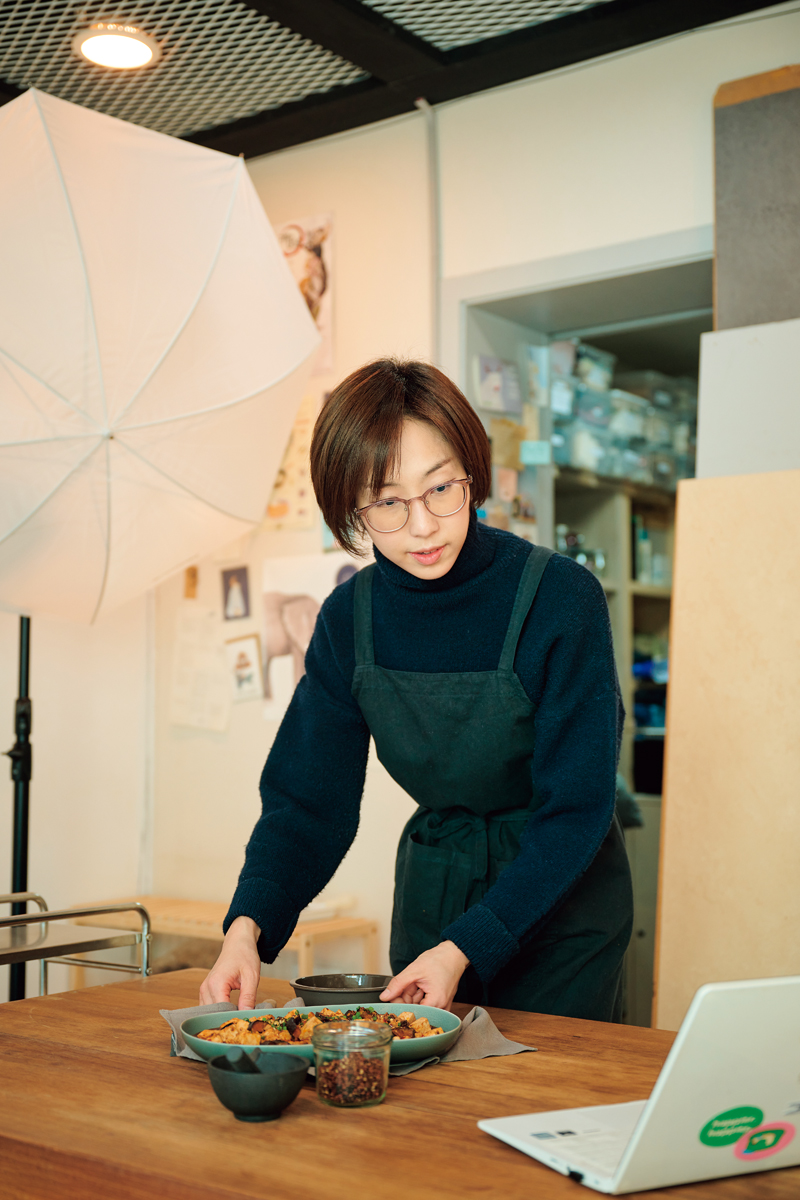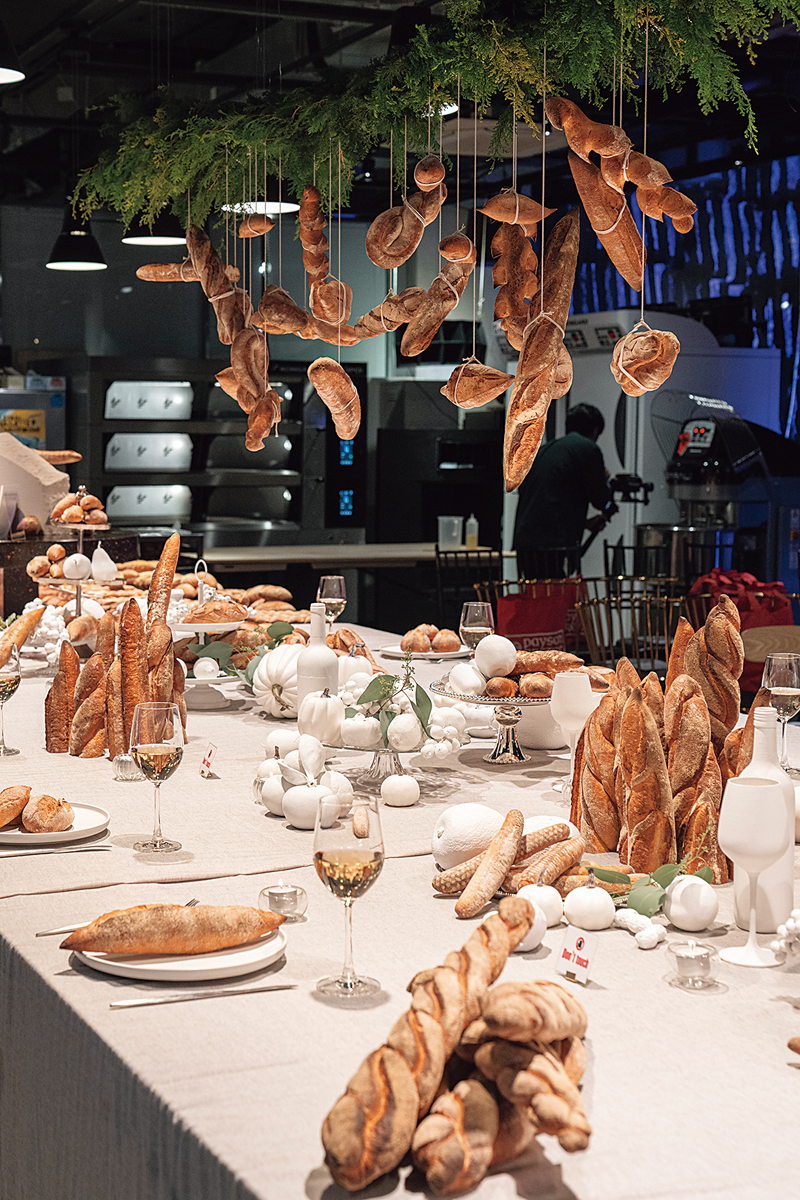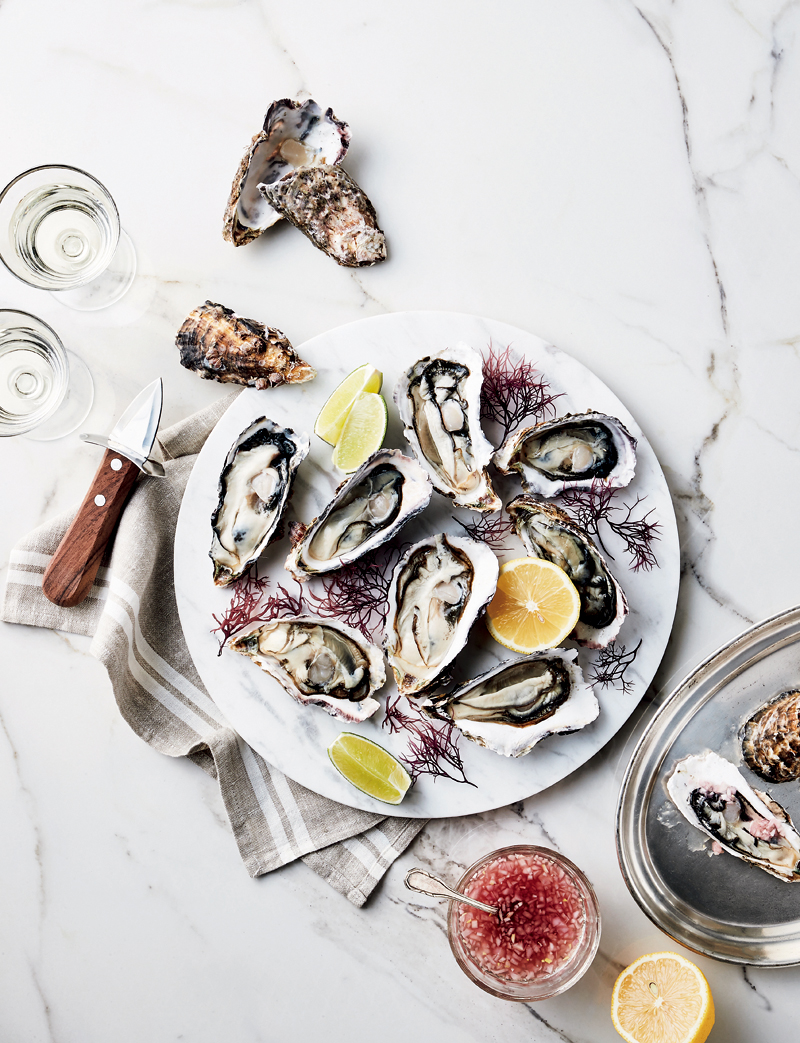Food stylists use food and tableware to orchestrate the presentation of table settings. They must convey the texture, taste, aroma, and appearance of food through photos or videos, which requires creativity and attention to detail.

Food stylist Kim Bo-seon checks the appearance of one of her dishes. Once she is satisfied, she must get her client’s approval.
Tucked away in an alley off a main road in Seoul’s Mapo District, there is a two-story house built some fifty years ago. It has no gate, and a large persimmon tree fills the corner of the yard. Birds from nearby Mt. Seongmi use it to rest, and the neighborhood’s curious cats and dogs drop by, attracted by the constant aroma of delicious food. A studio within operates day and night, sometimes as late as 3 a.m. It is the workplace of food stylist Kim Bo-seon.
Kim helps businesses maximize the appeal of dishes that appear on menus and packaging and in publications and cooking demonstrations. In addition to being an accomplished chef, she wears the hats of a culinary researcher, florist, coordinator, and designer throughout the day. Even with twenty years of experience, completing her clients’ requests often leads to a grueling, tightly packed schedule that can be subject to delays and disruptions.
JANE OF ALL TRADES
Kim usually wakes up at eight in the morning and walks to her nearby studio, which opens at nine. But when outdoor photo sessions are scheduled, she must get ready at five to begin shooting at nine. .
Before, most of the workload involved photographing food for print magazines, but as advertising has increasingly migrated to the internet, there are now fewer magazine shoots. “These days, my work mainly consists of branding projects on social media and setting up for exhibitions and events. Sometimes, when new kitchen appliances are launched, I test the products, develop new dishes, andbrochures,” Kim says.
Cooking and styling used to be treated as separate tasks, but now, Kim explains, the range of work depends on whether you know how to do both. “A food stylist needs to excel not only in cooking and styling but also in other areas, such as spatial design.”
“If the cooking isn’t up to par, there’s only so much you can do as a stylist, so you end up learning how to cook. For example, to enhance the look of a stir-fry dish, you need to decide whether to brush it with oil or glaze it with syrup, and to make that judgment, you need cooking knowledge. You also need to know at what temperature different types of meat look the most appealing. So, you must have an understanding of ingredients as well.”
Excelling in a country’s gastronomy may sound ideal but it does not guarantee success. Kim must be adept with a range of cuisines, including Korean, Western, Chinese, and Japanese, as well as their corresponding ingredients and cooking styles. “You never know what assignment may come your way, so you have to be able to do everything well.”

Kim’s design for the prestigious Le Pain Baguette Championship in 2023 featured breads suspended above an eight-meter-long table filled with different kinds of baguettes.
ⓒ Kim Bo-seon
EXPANDING HER HORIZONS
During her junior year at university, Kim happened to watch a TV program that described food styling and greatly inspired her.
“I had a lot of interest in cooking to begin with and wanted to do something related to it, but if you work at a restaurant, you end up making the same dishes day in and day out. On the other hand, the work of a food stylist — creating new dishes, making them look more inviting, and producing works for photo shoots — seemed more interesting to me.”
Kim took a leave of absence after her junior year and began actively pursuing her dream. However, at that time, no schools or academies had a curriculum dedicated to food styling. “I joined a class run by a teacher who was working as a culinary researcher and food stylist. But when the teacher had other things to do, the weekly class would be canceled or postponed, and there were times when it was held only once a month.”
As she learned food styling, she realized that she needed to step up her cooking skills, so she enrolled at the Culinary Training Center for Shilla Hotel. “My goal was to become an assistant to a food stylist after learning Western cuisine at the center, but there were too many candidates and not enough job openings. Thinking it would be advantageous to get some culinary experience, I began working at a trattoria.”
Using that experience as a stepping stone, she achieved her goal of becoming an assistant. In her senior year, she packed all her classes into one day and spent the rest of the week working. After graduation, she decided to study in Japan. “Back then, Japan had a more diverse range of cuisines and ingredients than Korea. The scope of desserts and wine, for example, was much broader, so I thought it would be an opportunity to expand my horizons.”
In Japan, Kim worked three part-time jobs to cover her living and educational expenses. Finally, in 2005, she returned to Korea and set up a small studio in the basement of her parents’ house, embarking on an independent career as a food stylist.
“There was no work. I’d only get a call every three months or so. Afraid of falling into depression if I just sat and waited, I continued studying by going to libraries and bookstores. Then, whenever I landed a job, I made sure I got a lot of practice out of it. I would test the camera angles several times to see which would be best, and in a shoot that only required a single cut, I’d make a back-up plan, and another back-up plan for that. It took me about five years to establish myself, and I’m indebted to repeat customers who introduced me to other potential clients.”

High-quality, fresh ingredients are essential to creating the color scheme and texture for an eye-catching presentation.
ⓒ Kim Bo-seon
ATTENTION TO DETAIL
When Kim receives a job request, her ensuing days entail discussions about the image to be d. This involves preparing everything: suitable tableware for the food, preparing and testing recipes, and selecting props for the atmosphere and presentation.
The latter includes coordinating tablecloths, napkins, utensils, seasoning containers, and flowers. While simple tasks may take about a day, more complex assignments, especially those involving hard-to-find ingredients or props, may take several days. The most crucial factor is the client’s approval, says Kim. A dish and presentation may be perfect in her eyes, but if it does not align with the client’s vision, she does not consider her work a success.
Photo shoots are scheduled about two to three times a week. In recent years, she only gets around four hours of sleep a night, so on days without shoots, she goes to work later or catches up on sleep. Otherwise, Kim tends to pre-production tasks such as purchasing items, testing recipes, and checking test photos, as well as organizing receipts and tax invoices and assigning tasks to her staff.
While Kim lends her culinary skills to millions of potential consumers, she hardly uses them for herself. Breakfast may be boiled eggs or a sweet potato, and lunch and dinner she has delivered. “There are plenty of good ingredients in the fridge, but I don’t have the time to cook or tidy up. I finish work early in the morning almost every day, so at home, I do almost nothing but sleep.”
Occasionally, when she has time, she meets people for a fine meal, but even that becomes an extension of work. When she sees particularly impressive food, she instinctively switches from diner to food stylist. She carefully studies the dishes and thinks of possible recipes if she was asked to style them.
“Food styling is creative work that can only be managed and executed when you have ideas. It’s not like brilliant ideas come to you just because you work from nine to five. That’s why it’s impossible to isolate work from everything else. This is something you can’t do if you don’t love the work. I used to be a person that gave up easily, but this job suits me. The more I work, the better I want to be.” Watching the birds flying around the persimmon tree in the yard offers Kim comfort and a short break — or perhaps some inspiration.
Hwang Kyung-shin Writer
Han Jung-hyun Photographer